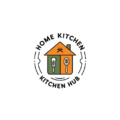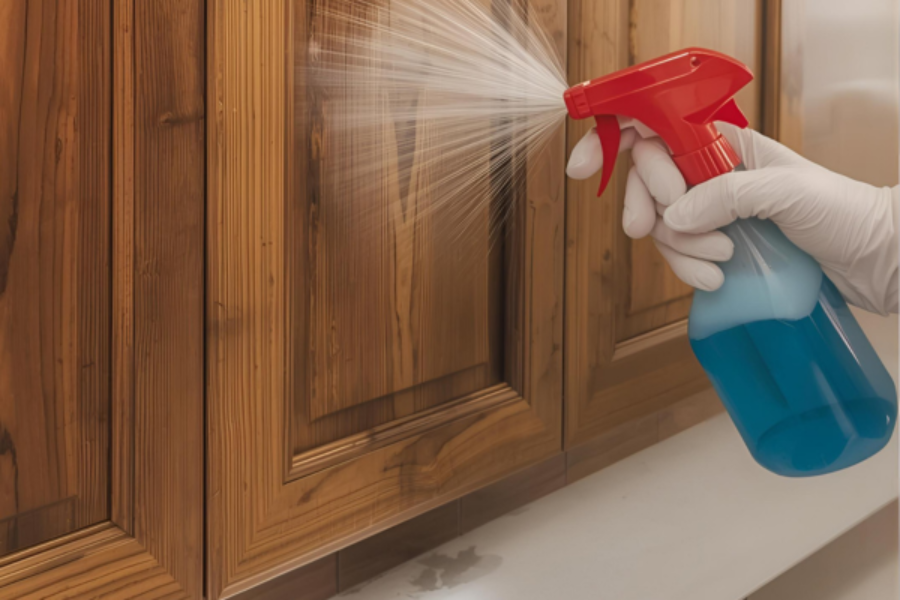We all know the kitchen is the heart of the home. It’s where we cook, entertain, and gather for meals. But with all the cooking, it’s no surprise that grease can build up quickly, especially on kitchen cabinets. Greasy kitchen cabinets not only look unsightly but can also become a breeding ground for germs, and if left unchecked, they can even affect the longevity of your cabinetry.
In this guide, we’ll explore why grease builds up on kitchen cabinets, provide you with the tools and cleaning methods you need, and give you tips to prevent future grease buildup. Whether you’re dealing with oily splatters from cooking or general kitchen use, this post will help you restore the shine and cleanliness to your kitchen cabinets.
Understanding the Causes of Greasy Kitchen Cabinets
Before we get into the cleaning methods, it’s important to understand the causes of greasy kitchen cabinets. Knowing why grease accumulates will help you address the problem effectively.
Cooking Oils and Food Splatter
The most common cause of grease buildup is cooking oils. When you fry, sauté, or cook with oils, tiny droplets of grease can escape and cling to surfaces. Over time, this forms a thick, sticky layer on your kitchen cabinets. Food splatters from sauces, gravies, and other dishes can also contribute to the greasy residue.
Regular Exposure to Heat and Steam
Heat and steam from cooking also contribute to grease sticking to cabinet surfaces. The stove, oven, and range hood can all release moisture into the air, which then condenses onto nearby surfaces, including your cabinets. This is especially true for areas near your cooking appliances.
Lack of Regular Cleaning
Another factor is simply neglecting regular cleaning. If you don’t wipe down your cabinets frequently, the grease has time to build up in Cleaning Guide for Home & Kitchen layers, making it harder to remove later. It’s always better to clean a little bit regularly than to let grime accumulate over time.
Tools and Cleaning Supplies You’ll Need
Cleaning greasy cabinets doesn’t require expensive or specialized products. With a few basic supplies, you can tackle the grease and restore your cabinets to their original shine.
Basic Supplies
- Dish Soap, Warm Water, and Microfiber Cloths: These are your go-to tools for a basic cleaning. Dish soap is a mild degreaser, and microfiber cloths work wonders for trapping dirt and grease without leaving streaks.
- Baking Soda and White Vinegar: These common household products are natural cleaners. Baking soda works as an abrasive to scrub away tough grease, and vinegar helps break down grease without harsh chemicals.
- Dish Scrubbers or Soft-Bristled Brushes: These tools help you scrub away grease without damaging the surface of your cabinets.
Specialized Cleaning Products
- Grease-Cutting Cleaners or Degreasers: If the grease is particularly stubborn, products specifically designed for removing grease, such as Simple Green or Krud Kutter, will work wonders.
- Wood-Safe or Cabinet-Safe Cleaners: If you have wooden cabinets, use a cleaner designed for wood to avoid damaging the finish.
- Commercial Cleaners: Products like Goo Gone or Magic Erasers can help remove tougher stains and residue.
Optional Tools for Heavy Cleaning
- Steam Cleaner: If the grease buildup is particularly tough or widespread, a steam cleaner can help loosen grime in hard-to-reach areas.
- Toothpicks or Small Brushes: These are helpful for cleaning tight crevices and corners that can collect grease.
Step-by-Step Guide on How to Clean Greasy Kitchen Cabinets
Now that you have all the tools you need, let’s dive into the step-by-step process for cleaning greasy kitchen cabinets.
Step 1: Empty the Cabinets
First, remove all items from your cabinets, including dishes, food, and cleaning products. Emptying the cabinets ensures that no items are contaminated with grease and gives you better access to all surfaces. It also prevents any accidental spills during the cleaning process.
Step 2: Dust and Wipe Down Surfaces
Start by dusting off the surfaces to remove any loose dirt, dust, or debris. Wipe down the cabinets with a dry cloth to clear any loose particles. This ensures that you don’t smear dirt around when you apply your cleaning solution.
Step 3: Create Your Cleaning Solution
Next, mix your cleaning solution:
- For general cleaning, mix a few drops of dish soap with warm water in a bowl or bucket.
- For tougher grease, make a paste by mixing baking soda and water.
- For a natural degreaser, mix one part vinegar to one part water. The acidity of vinegar helps break down grease without using harsh chemicals.
Step 4: Apply the Cleaner
Dampen a microfiber cloth with your cleaning solution, then apply it to the greasy areas of the cabinets. Let it sit for a few minutes to break down the grease. For heavy buildup, you may need to apply more solution and allow it to sit longer.
Gently scrub the grease with a microfiber cloth, dish scrubber, or soft-bristled brush. Avoid using harsh scrubbers that could scratch or damage your cabinets.
Step 5: Focus on High-Traffic Areas
Pay special attention to high-traffic areas where grease tends to accumulate, such as around the handles, knobs, and hinges. These areas often collect food oils and can become particularly grimy.
Don’t forget to clean the edges of your cabinets, under the shelves, and any other tight spaces where grease may have settled.
Step 6: Rinse and Wipe Down
Once the grease is gone, rinse your cloth or sponge in clean water and wipe down the cabinets to remove any leftover cleaner. Dry the cabinets with a microfiber towel to prevent water spots or streaks.
Step 7: Clean the Cabinet Doors and Handles
Cabinet doors and handles often accumulate fingerprints and grease. Use a mild cleaner to wipe down the doors, and a specific polish for handles if needed. This will give your kitchen a fresh, clean look.
Special Cleaning Tips for Different Cabinet Materials
Cabinets come in all different materials, so it’s essential to use the right cleaning method to avoid damaging the finish.
Wood Cabinets
Wooden cabinets need special care. Avoid excessive water or harsh chemicals that can damage the wood. Use a wood-safe cleaner and apply a natural oil like lemon oil or olive oil after cleaning to restore shine and protect the finish.
Laminate or Veneer Cabinets
Laminate or veneer cabinets are more resistant to moisture, but they can still be scratched easily. Use a non-abrasive cleaner to avoid damaging the surface. If grease has discolored the laminate, you may need to use a gentle abrasive cleaner or a commercial product like Goo Gone.
Metal or Stainless Steel Cabinets
Stainless steel can be prone to streaking, so use a dedicated stainless steel cleaner or a vinegar and water mixture to remove grease. Avoid using abrasive sponges that could scratch the surface. For stubborn spots, you can apply a small amount of oil to restore the shine.
How to Prevent Grease Buildup in Kitchen Cabinets
Once your cabinets are sparkling clean, it’s time to think about preventing future grease buildup.
Regular Wiping and Maintenance
The best way to prevent grease buildup is to clean your cabinets regularly. Wipe them down once a week or at least once a month, depending on how often you cook. A quick microfiber cloth wipe-down can keep grease from accumulating.
Use a Kitchen Ventilation System
Install or use an effective range hood or exhaust fan to reduce the grease in the air. Ventilation will help reduce the amount of oil and steam that sticks to your cabinets, preventing buildup.
Apply a Protective Finish
Consider using a protective finish on your cabinets, such as a wax or a specialized cabinet coating. This can create a barrier that helps prevent grease from sticking and makes cleaning much easier in the future.
When to Call a Professional for Cleaning
Sometimes, cleaning grease off kitchen cabinets can be a tough task. If you’ve tried all DIY methods and the grease won’t budge, it might be time to call a professional.
Tough, Stubborn Grease Stains
If grease has seeped deep into your cabinets, causing discoloration, or if DIY cleaning methods don’t work, a professional cleaning service may be able to help.
Heavy Kitchen Renovations
During a full kitchen remodel, a professional cleaning service can deep clean your cabinets to prepare them for repainting or refinishing.
Specialized Cabinet Cleaning Needs
Antique or high-end cabinets may require special care and attention. If you have valuable cabinets, it’s best to consult a professional for cleaning to preserve their integrity.
FAQ Section
Q1: Can I clean greasy kitchen cabinets without harsh chemicals?
Yes, using natural alternatives like vinegar, baking soda, or essential oils can help remove grease safely and effectively.
Q2: How often should I clean my kitchen cabinets?
It’s a good idea to wipe down your kitchen cabinets at least once a month to prevent grease buildup. However, if you cook frequently, a weekly cleaning is ideal.
Q3: How do I remove grease from wood cabinets without damaging the finish?
Use a mild dish soap solution, and always wipe with a soft cloth. Avoid soaking the wood and be careful with abrasive scrubbing tools.
Q4: Can I use a steam cleaner to clean greasy kitchen cabinets?
Yes, a steam cleaner can be an effective tool for removing stubborn grease, especially in hard-to-reach areas. Make sure the cabinet material is steam-safe.
Q5: What is the best product for cleaning stainless steel cabinets?
For stainless steel, use a dedicated stainless steel cleaner or a mixture of vinegar and water. Avoid abrasive sponges to prevent scratching the surface.
Q6: How do I prevent grease from building up on kitchen cabinets?
Regular cleaning, using a range hood, and applying protective finishes are great ways to prevent grease from accumulating on cabinets.
Conclusion
Cleaning greasy kitchen cabinets doesn’t have to be an overwhelming task. With the right tools, cleaning solution, and techniques, you can restore the shine to your cabinets and maintain a fresh, clean kitchen. Regular cleaning, proper ventilation, and protective finishes will go a long way in preventing future grease buildup.
By following the steps in this guide, you’ll not only keep your kitchen looking great but also extend the life of your cabinets. So don’t wait—start cleaning today and enjoy a grease-free kitchen for years to come!

